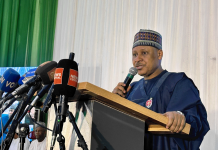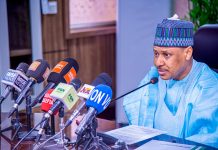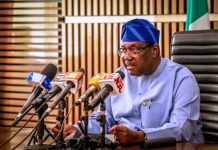
The Transition From Analogue To Digital Terrestrial Television Broadcasting In Nigeria: Our Journey So Far
Protocol:
Please permit me to formally welcome the Her Excellency, the Minister of Communication from the Republic of Niger, Madam Sani Koubra Abdoulaye, and her entourage, to the Federal Republic of Nigeria.
Like Niger, Nigeria was a Signatory to the Geneva 2006 (GE-06) Agreement for the Digitization of Terrestrial Television Broadcasting
Shortly after the World Radio Conference of 2007, Nigeria set up a Presidential Advisory Committee (PAC) to advise Government on the way forward and draw up the Road Map for the Transition.
This Committee submitted its report on 20th June 2009 with a Road Map that targeted a switch over by 17th June 2012. Unfortunately, due to unforeseen circumstances, the Implementation Committee for the Transition could not be inaugurated until 22nd December 2012. Even then, the Committee, called DigiTeam Nigeria, was not empowered to carryout its responsibilities.
The guiding document for the Transition in Nigeria is The Government White Paper resulting from the Recommendations of the Presidential, Advisory Committee Report. Going forward, the following Key Policy Decisions were taken by Government:
– There shall be a separation of functions in the Broadcast Industry in Nigeria:
– The Broadcaster will be responsible for the Content of Broadcasting
– Signal Distributors will be responsible for the Transmission of the Programmes to the viewers
– A maximum of 3 Signal Distributors will operate in Nigeria, one of which will evolve from the transmission facilities of the Federal Government-owned National Broadcaster, The Nigerian Television Authority, NTA.
– The Set Top Boxes (STBs) to enable the existing Analogue Television Receivers to continue receiving the Digital Signals are to be Assembled/Manufactured in Nigeria, reason being that Nigeria will need over 30 Million STBs for the Transition. Moreover, to further exploit the Economy of Scale, it was agreed to adopt a Common Minimum Standard for Set Top Boxes in the ECOWAS Sub-Region. This implies that STBs manufactured in Nigeria can also be available for use in all the ECOWAS Countries.
Working with Broadcasting and Telecommunications of all ECOWAS Countries, with assistance from the International Telecommunication Union (ITU), a Common Standard was developed for both the Digital Transmission Network and the STBs for the ECOWAS Countries. These Standards were approved at the 25th September 2013 meeting of all ECOWAS Ministers of Information/Broadcasting and Telecommunications in Banjul, Gambia.
In line with the Government Policy in Nigeria:
– Two Signal Distributors have been licensed:
– One, Integrated Television Services Limited –from the Transmission Infrastructure of the NTA – Owned by Government and
– The second by Open, Transparent and Competitive Bidding – PINNACLE Communications Limited, which is privately-owned.
– Thirteen companies were authorized to manufacture STBs in Nigeria. Manufacturing STBs in Nigeria requires a huge Capital outlay, hence the investments of these Manufacturers need to be protected in Nigeria. Therefore, a Conditional Access System (CAS) has to be imposed on the System. A Company – INVIEW Limited – was contracted to provide the CAS Software. This implies that every STB has to be individually activated via it’s Unique Identity Number. It therefore became necessary to engage the services of a Call Centre Operator. This Centre handles STB Activation as well as any other Consumer Issues relating to the Digital Transmission. This is being handled by a Company- Outsource Limited.
– Currently a company – Cable Channels Nigeria Limited (CCNL) – is assisting to aggregate signals from the various Free-to-Air Stations to the Head End of the Signal Distributors.
HOW FAR HAVE WE COME?
The main thrust of the DTT Process in Nigeria commenced with the Pilot Project in Jos, Plateau State of Nigeria, which was successfully launched on 30th April 2016. This was done on the Platform of ITS and offered 16 Free-view Channels of Programming. Jos was an ideal location for a Pilot Study. The population was not too large but historically this is where the Transition from Black and White to Colour Television commenced in Sub-Saharan Africa. It had an ample mix of government-owned and privately-owned television stations and the topography of the Plateau is quite challenging for signal transmission.
A lot of lessons were learnt from this Pilot which were now carried forward to the actual commencement of the Digital Television Roll Out in the nation’s capital, Abuja, on 22nd December 2016. Most of Abuja is now Digital, apart from a few Shadow Areas that require Gap Fillers.
By the end of June and 1st week of July, we will be rolling out in six different States in the Six Geo-Political Zones of Nigeria and we will continue the Roll Out until the whole country is digitized.
CHALLENGES:
A major challenge to the DSO is the availability and cost of STBs. Even when you achieve a Nationwide Signal Coverage, you cannot shut down the Analogue Transmitters until all the TV Homes have access to STBs. So far, the government has had to subsidise STB acquisition in the Roll-Out. This is not sustainable for the larger population of the country. So we are currently exploring avenues to make the retail cost of STBs affordable to the general public without compromising the ECOWAS Minimum Standard. Subsidy in one form or the other will then be extended to those below the poverty line.
Rest assured that this Government has the political will to make the DSO a success story to the benefit of all Nigerians and to the ECOWAS Community in the areas of the application of the Digital Dividends However we will take our time to do it right.
Another area of challenge is the Content of Broadcast. Because of digitization, we now have opportunity for many more channels of programming. When all the technology is in place what are you going to feed your public through all these available channels? The easiest way to colonize the minds of our people is via the Mass Media. If we do not seriously address the issue of Compelling Indigenous Content, we will be exposing our population to further colonization.
Finally, let me commend Her Excellency, Madam Minister, for embarking on this visit. The visit is important because it shows the need for ECOWAS Member Countries to work together, especially in sharing best practices, to ensure a successful migration from Analogue to Digital, not only in our individual countries but also collectively for the benefit of our people across the sub-region.
Once again, Your Excellency, Madam Minister and your entourage, welcome to Nigeria.





